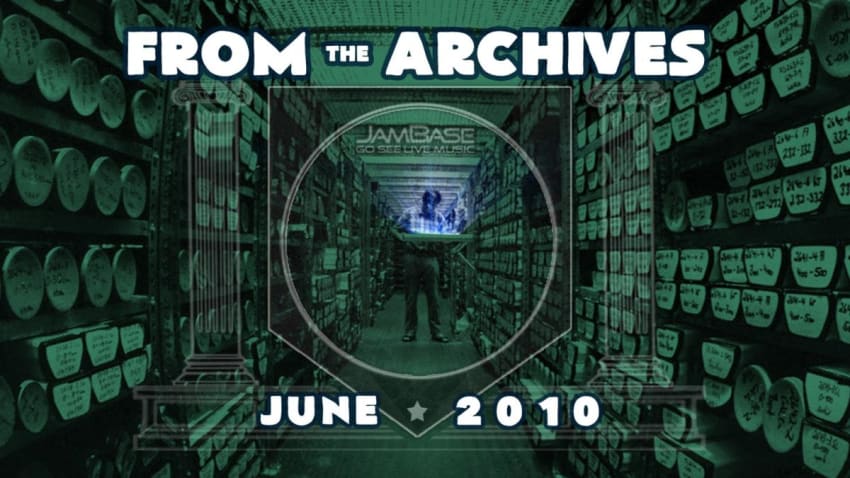Jacob Fred Jazz Odyssey | 06.12 | Oklahoma
By Team JamBase Jun 28, 2010 • 7:03 pm PDT

Jacob Fred Jazz Odyssey :: 06.12.10 :: OK Mozart Festival :: Bartlesville, OK
 |
Brian Haas (piano), Josh Raymer (drums), Chris Combs (lap steel) and new addition bassist Jeff Harshberger looked as squeaky clean as I’d ever seen them, excited in their crisp suits and itching to jump into the fruition of a journey that began years ago. Haas has been struggling to adapt Beethoven for ages, and after a false start in Brooklyn earlier this year they found their ideal creative foils in Faingold and Bartlesville Symphony music director Lauren Green, who both grokked how JFJO isn’t like the other children, even when they are playing with a very known quantity like Beethoven. In a pre-concert discussion, Faingold said he realized some time ago that “a classical symphony with acoustic instruments could be way bigger than a metal band.” It’s this kind of outside-the-box perspective that makes him such a good fit for this particular band; though he admitted he was “initially paralyzed by [JFJO’s] approach, which really pushed everyone’s boundaries.”
This last point is vitally important with Ludwig because if classical works aren’t doomed to be artifacts laboriously recreated the boundaries must be pushed. We aren’t reading by whale blubber lanterns anymore, and kings don’t decide what’s appropriate music and what isn’t. We are wireless citizens of the world with whole record collections in our pocket. As such, antiquated modes of interpretation come off as particularly dusty, like the French in Vietnam in the ’60s desperately clinging to their privileged colonial existence before the populist uprising. If Beethoven isn’t going to be a relic studied and admired under glass he needs wild creatures like JFJO to dig their nails into his hide and pull out the meat underneath.
 |
What first grabbed my attention was the level of swing infused into what can be somewhat academic music. Face it, much of the appeal of classical music is cerebral, and those that know things about this music are often prideful and disdainful of those that don’t. Beginning with the pastoral inflections of the 6th Symphony, the ensemble immediately had more hips than one usually associates with Beethoven, inspiring some gentle head-nodding with their collective gait.
As the second movement emerged, the melting notes and unruly tone of Combs’ lap steel REALLY set this performance apart. Combs’ presence and instrumentation was likely the most contentious aspect of this re- imagining to many of the OK Mozart regulars, who perhaps didn’t appreciate how wonderful a lap steel can be in the hands of an innovator like Combs. Combs’ high reaching guttural tones played nicely against Haas’ music box piano. And it was Haas who seemed the most uncharacteristic, curtailing his usual penchant for robust improvisation and serving something larger, something that required a delicacy and humility that a normal JFJO show does not. Raymer, too, exhibited real control and focus, placing each stick strike with care and caressing his cymbals like a lover. Where jazz seemed to come into play was in the general glide and individual solos, which didn’t bow to the church of violin like much classical fare.
 |
I’d hazard a guess that this is the most rim-shots and hard snare taps the 3rd has ever experienced, not to mention the uniqueness of the strong samba flavors in the 2nd movement, which brought to mind Antonio Carlos Jobim and film composer Bernard Herrmann, and made the symphony dance in a new, alluring way. Sexy stuff.
The third movement was a wondrous sandbox of ideas for everyone to toy with, moving things around from pomp to romp. Classical music is rarely funny, except in perhaps a very dry, droll way. Here, the players delighted in tickling the audience, tossing notes into the air in a manner that suggested a childlike rediscovery of what had drawn them to this music in the first place. This infectious feeling carried the symphony to an honestly rousing conclusion where the faces of JFJO and their collaborators signaled their awareness that they’d pulled off something significant.
Beethoven’s writing – like most classical music – has a mathematical logic to it but this felt closer to today’s theoretical mathematics and its string theories and quantum logic. Instead of being locked away by the culture police, Beethoven got to stretch his legs a good bit. Ludwig has the potential to connect with younger audiences who wouldn’t know Dvorak from Devo. Ludwig will likely be refined as big city orchestras take a shot at it and Haas and company tweak it further, but in the moment one could be sure they were present at the birth of something lovingly crafted and deeply felt.
JFJO released their swell new studio album Stay Gold on June 22. Find out more here.
JFJO Tour Dates :: JFJO News :: JFJO Concert Reviews
JamBase | Oklahoma
Go See Live Music!

